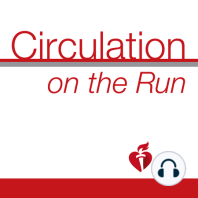18 min listen
Circulation May 21, 2019 Issue
ratings:
Length:
26 minutes
Released:
May 20, 2019
Format:
Podcast episode
Description
Dr Carolyn Lam: Welcome to Circulation on the Run, your weekly podcast summary and backstage pass to the journal and its editors. I'm Dr Carolyn Lam, Associate Editor from the National Heart Center and Duke National University of Singapore. Dr Greg Hundley: And I'm Greg Hundley, Associate Editor of Circulation and Director of the Pauley Heart Center at VCU Health in Richmond, Virginia. Well, Carolyn, our feature article is going to focus on trastuzumab-induced cardiac dysfunction in breast cancer patients. We will discuss with Stanford investigators their use of pluripotent stem cells that are differentiated to cardiomyocytes and subsequently exposed to toxins to determine an individual's susceptibility to cardio-toxicity from cancer treatment. But before we get to that, Carolyn, do you have a paper that you'd like to discuss? Dr Carolyn Lam: Well, the first paper deals with cardiac biomarkers and asks the questions, can these biomarkers be useful for the diagnosis and risk stratification of syncope?" Now, this paper is from Dr Mueller and colleagues from University of Hospital Basel in Switzerland. They evaluated the diagnostic and prognostic accuracy of BNP, NT-proBNP, high-sensitivity cardiac troponin T, and high-sensitivity cardiac troponin I concentrations, alone and against the ones of clinical assessments in more than 1,500 patients presented with syncope to the emergency department in a prospective, diagnostic multi-center study. Now, cardiac syncope was adjudicated in 234 or 15% of patients. What they found was that the diagnostic accuracy from cardiac syncope, as quantified by the area under curve, was 0.77 to 0.78 for all four biomarkers. That was superior to that of the syncope-specific diagnostic score, EGSYS. Now, combining the four biomarkers further improved diagnostic accuracy to an area under curve of 0.81. Furthermore, using the four biomarkers at cutoffs achieved predefined thresholds for sensitivity and specificity and allowed rule-in or rule-out of 30% of all patients. Finally, the biomarkers predicted adverse cardiac outcomes with moderate to good prognostic accuracy and better than some of the existing syncope risk-prediction scores. Dr Greg Hundley: Very interesting, Carolyn. Do you think we can now use this clinically? Should we be drawing these biomarkers on patients with syncope? Dr Carolyn Lam: These results really do imply that these biomarkers look like useful tools for the early rule-out and/or rule-in of cardiac syncope in the emergency department. After all, these biomarkers are readily available, inexpensive, and results of this study suggest that they have potential to simplify diagnosis and to risk stratify in challenging presentations. However, before embracing the concept of ordering cardiac biomarkers routinely for syncope presentation, we really need to read the editorial by Dr Sandhu and Sheldon, in which important perspectives are presented, such as considerations of the certainty of the diagnosis of syncope, the usefulness of the comparative scores, the timing of testing, the potential unintended adverse consequences of testing. These editorialists concluded that, although promising, further work is needed to determine how the use of cardiac biomarkers should be incorporated into a risk-stratification algorithm. Dr Greg Hundley: Wow, Carolyn. It sounds like we'd get a lot out of that particular editorial. I'm going to switch over and talk about NT-proBNP in patients with pulmonary hypertension. This is a paper from Dr Kelly Chin from UT Southwestern, and the study evaluated the utility of end terminal pro BNP level thresholds and assessing prognosis in pulmonary hypotension using the GRIPHON study. So GRIPHON is a global double blind, randomized placebo control event driven phase 3 study which assesses the safety and efficacy or a Prostacyclin agonist that
Released:
May 20, 2019
Format:
Podcast episode
Titles in the series (100)
Circulation January 23, 2018 Issue by Circulation on the Run
